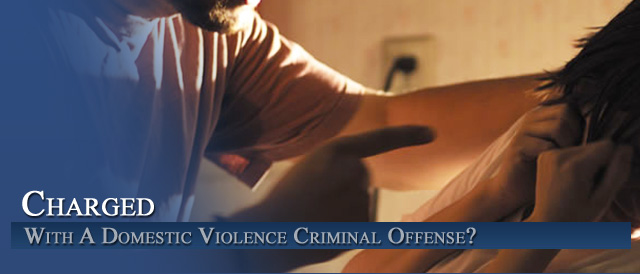




Colorado Domestic Violence: An Industry
H. Michael Steinberg – Colorado Criminal Domestic Violence Specialist
The special nature of domestic violence allegations
True domestic violence must stop. No rational person condones violence toward anyone, particularly a family member or intimate partner. In America there are many tragic domestic relationships that involve battered men, women, and children. A true victim in a violent intimate relationship needs immediate support and protection. A true batterer needs to face the legal consequences of their actions.
But the term “batterer” is commonly misused in domestic violence debates. Battering does not refer to a single argument, nor does it mean the occasional conflicts that many couples have that may grow to yelling at each other and some pushing or shoving. Rather, battering involves beating and verbally abusing an intimate partner over a long period of time.
Innocent family members can be falsely accused of domestic violence
The Colorad State Legislature has enacted laws to assist police and prosecutors convict the guilty and stop the abuse of intimate partners and family members. The intent behind these laws is well meaning but problems arise when laws designed to protect a victim of domestic violence are used too broadly and are applied to normal families and relationships. A big difference exists between an abusive partner repeatedly committing violent acts, and a nonviolent family or relationship in which a single argument went too far.
Unfortunately, the politicians and authorities do not see the difference. To the self-proclaimed saviors and protectors of abused “victims,” any allegation of domestic violence means the relationship must be one continuously engaged in abusive behavior. As John Maquire puts in his article The Booming Domestic Violence Industry in Massachusetts News:
“The domestic violence entrepreneurs and state officials live in a different world from us. A sense of nameless vague threat is always in the background. To hear the pros talk, all the men they deal with are batterers, sexual abusers, or virtually time bombs of violence. Repeated cliches like “at risk” and “a safe place” and “maintaining safety” pepper their sentences. Yet, in many cases, there is no evidence of violence or any kind of serious harm to children, merely an accusation by the mother. But in the DV industry, when the accusation is made, the case is closed.”
If an argument between intimate partners and spouses is the benchmark for domestic violence, then almost every couple and family in America would be defined as an abusive relationship. This governmental overreaction, and dragnet targeting of normal families and relationships, and treating them as criminals has led us to massive injustice across the nation.
Examples of what is not domestic violence
Husbands and wives, boyfriends and girlfriends, have arguments. Does that now mean, or justify, a trip to jail and a criminal conviction with lifetime penalties?
Human beings make mistakes, cause accidents, and act immaturely at times. Everyone has past conduct they wish could be taken back. Part of being human is sometimes hurting those loved the most. The absurdity is to classify a single, out-of-character, nonviolent act as “criminal.”
For instance, it is not domestic violence to:
• Yell and scream at our girlfriend, spouse, or another household member, even if the neighbors hear it;
• Use profanity during an argument with a girlfriend, spouse, or household member;
• Engage in minor pushing incidents with a girlfriend, spouse, or household member;
• Engage in consensual sex that may be loud or rough, e.g., see The Joy of Sex;
• Engage in horseplay, wrestling matches, and pillow fights or similar mock combat even if accidents result;
• Hold the arm or hand of a girlfriend, spouse, or household member while arguing;
• Restrain an intimate partner to prevent them from hurting themselves or another family member;
• Momentarily block the path of a girlfriend, spouse, or household member;
• Throw and break items during an argument, or engage in consensual S&M;
• Awake violently from a nightmare, or react violently when someone awakens you suddenly;
• Say hurtful and mean things to a girlfriend, spouse, or household member;
• Use self defense to stop a girlfriend, spouse, or household member from attacking you.
• Serve, or have served in the Armed Forces of the United States, nor is such service a reasonable basis for “fear” in a rational and sane individual.
With “Zero Tolerance” arrest policies and “No Drop” prosecutions, the number of arrests for petty family arguments has skyrocketed. A former prosecuting attorney explains the phenomena:
“Christopher Pagan, who was until recently a prosecutor in Hamilton County, Ohio, estimates that due to a 1994 state law requiring police on a domestic call either to make an arrest or to file a report explaining why a no arrest was made, “domestics ” went from 10 percent to 40 percent of his docket. But, he suggests, that doesn’t mean actual abusers were coming to his attention more often. “We started getting a lot of push-and-shoves,” says Pagan, “or even yelling matches. ” In the past, police officers would intervene and separate the parties to let them cool off. Now those cases end up in criminal courts. It’s exacerbating tensions between the parties, and it’s turning law-abiding middle class citizens into criminals.”
Cathy Young, Domestic Violations, Reason Magazine, April 1998
Who is the real victim anyway?
The legal definition of a crime “victim” is not what one might think. The word “victim” seems to mean the person who was assaulted, stabbed, murdered, or had their property stolen. Under the law, however, the “victim” of a crime is the “State.” All criminal cases are therefore styled: “The State of Colorado vs. The Defendant.”
Once the authorities become involved in a domestic disturbance, they will forever be intertwined with the eventual outcome of the incident. The State, meaning the government, police, and prosecutors, solely decide if a case will be prosecuted or dismissed. Even if the “real victim,” i.e. the person who supposedly was assaulted, informs the authorities of their desire to have the case dismissed, the charging decision is still left up to the government.
A constant complaint from those at the center of a domestic violence investigation is how irrelevant the family is to the investigative team. The team wants to win the case. It wants a criminal conviction. And will do anything to get it. The team, despite its public overtures, does not care about the individual family it is making life-altering decisions for. The family, alleged victim, defendant, and children alike are all mere pawns, literally at the mercy of this governmental machine.
The machine knows very well how to destroy families, yet it knows nothing of healing them.
“The woman sitting across the table often breaks into tears and fits of trembling. She lives in fear. She says she has been threatened and emotionally battered by those who call themselves “front-line workers” in the war against violence against women. Since the violence against women specialists invaded their lives a year ago, husband and wife have developed ulcers, been financially battered and say they survived many attempts to break up their marriage.
Now they’re angry…From the start the advice from support workers connected to the Domestic Violence Court was that she should break up her marriage. She should not risk living with a violent man.
Her attempts to defend her husband were met with we-understand-and-we-know-better attitudes; she was afraid of him and was trying to protect him so he wouldn’t be angry. When it became clear she had no intention of separating from her husband, the threats from domestic violence specialists connected to the court moved to a new level that still terrifies her.
‘They seemed to be threatening to take my child. They said if I wasn’t going to protect my child from his father, then the system would have to. ”I learned it’s a system that doesn’t listen. ‘”
Dave Brown, The Ottawa Citizen, 2001
Cult of The Domestic Violence Industry: Zero tolerance and no drop policies
In the Domestic Violence industry, when the accusation is made, the case is closed.
John Maguire, The Booming Domestic Violence Industry, Massachusetts News
In response to the need to supply the necessary bodies to perpetuate the domestic violence industry, law enforcement has adopted a new tool: Zero Tolerance.
What does “Zero Tolerance” mean? Two police officers will be dispatched to a home regarding a domestic disturbance. They will not arrive empty handed. Patrol units, equipped with computers, enable officers to quickly determine if this address has had any prior domestic incidents. Officers will know the complete criminal history of each spouse before arrival.
The police will typically find a household in which a man and woman have argued and are emotionally upset. The officers will separate the parties and conduct a brief interview of each one’s version of events. The police will look for physical signs of violence, such as bleeding, red marks, or scratches on the individuals. They will also search the house for signs of a struggle, thrown ashtrays, knocked over furniture, spilled food or drinks, pictures askew on the wall, etc. [Ed. note: No warrant is required for such a search in domestic cases.]
Then the two officers will confer with each other and compare stories. A decision to arrest will then be made. This entire “investigative” process can be completed in mere minutes, with the arrest decision made in a split second.
‘What couple does not encounter stress, especially when they have children? But in the fever of emotion, a woman can call ” 911″ and have three police cars there in minutes. After this fateful act, she loses all control. The state prosecutes her husband whether she likes it or not. He is jailed and prohibited from returning home… And all they wanted was the police to defuse a tense situation…This policy (Zero Tolerance) is designed to accustom society (both police and victims) to the intrusion of the state into private lives. Couples are arrested just for having an argument. Neighbors phone the police. What’s next? Cameras in our homes just like George Orwell’s
“1984” ‘? Editorial, Winnipeg Free Press, “Zero Tolerance,” February 10, 2002
“Zero Tolerance” by the police leads to a “No-Drop” policy by the prosecution. An arrest means the case will be prosecuted. The “protectors” view of their job entails ending the relationship for the safety of the “victim.” Prosecutors are not concerned with the wishes or needs of the real victim. The “No Drop” policy requires the case to go to trial even if the real victim wants the charges dismissed. “No-Drop” means the government will push the case all the way regardless of hardship upon the family. To the entrepreneurs of the Family Violence Industry, “helping” the victim necessitates separation of the family, enforced through protective orders, followed by divorce. In addition, the helping agenda probably includes loss of employment for the accused spouse, financial hardship, and adding unnecessary emotional stress to a family.
“Zero Tolerance” means that the government, not you, the government, knows what is best for your family and children. If the government is so concerned about stopping family violence and helping families, why would they push prosecution when the family is asking them not to?
The Domestic Violence Industry
The government has definitely made its way into family violence:
“Like many crusades to stamp out social evils, the War on Domestic Violence is a mix of good intentions (who could be against stopping spousal abuse?), bad information, and worse theories. The result has been a host of unintended consequences that do little to empower victims while sanctioning interference in personal relationships.”
Cathy Young, Domestic Violations, Reason Magazine, April 1998
Every few years a new “crime de jour” is created. This phenomenon begins with a legitimate social problem needing to be addressed. Examples in recent years of “crimes de jour” include “Driving While Intoxicated” and “Child Sexual Abuse.” The tragic consequences of isolated worst-case scenarios of these crimes are highly publicized. The nation is inundated with media coverage and informed the problem is not being adequately dealt with by the criminal justice system. Crime victims form support groups (such as M.A.D.D. — Mothers Against Drunk Driving), and these support groups in turn create lobby groups. The lobbyists influence the media, judges, and politicians. Political candidates sense community outrage and run campaigns with platforms designed to solve the “crime de jour.” After each campaign year and legislative session, new laws address perceived omissions, loopholes, and provide additional punishment for those convicted of the “crime de jour.”
The enactment of such special interest group legislation officially converts the ” crime de jour” into a ” political crime.” “Some crusaders openly argue that domestic violence should be taken more seriously than other crimes. In 1996, the sponsor of a New York bill toughening penalties for misdemeanor assault on a family member (including ex-spouses and unwed partners) vowed to oppose a version extending the measure to all assaults: “The whole purpose of my bill is to single out domestic violence,” Assemblyman Joseph Lentol said. “I don’t want the world to think we’re treating stranger assaults the same way as domestic assaults.”
The current ” crime de jour” is domestic violence.
A strange conglomeration of individuals pushing varying agendas comprise the force behind the domestic violence movement. The movement combines legitimate victims and their advocate supporters with professional vendors who have much to gain through concentrated efforts to expand the industry:
“These people, some idealistic and some merely pragmatic, have networked, talked with each other, served on various commissions, boosted each other’s careers, and helped to expand the definition of family violence, and the size of state and federal funding massively. Only ten years ago, the women’s safety-advocates were a small group of idealists, operating on pennies. Today the movement has grown large on state and federal tax monies. Every month, it seems spawns new sub-programs, clinics, shelters, research institutes, counseling centers, visitation centers, poster campaigns. Today, domestic violence is a big industry.
Mapping the full extent of the domestic violence industry is not easy, because it’s a cottage industry, spread out in hundreds of places. State and federal money (in each state) goes to well over a hundred institutes, clinics, programs for counseling or outreach or coordination or training, computer databases, coalitions, shelters, PR agencies and other groups.”
John Maguire, The Booming Domestic Violence Industry, Massachusetts News
The media, pressured by women’s safety advocate groups has perpetuated public hysteria by over inflating the true incidence of domestic violence. While a legitimate social problem and cause for reasonable concern, the response to the force-fed hysteria has been legislative overkill.
Follow the money
Federal law provides funding to states for the creation, development, and utilization of Family Advocacy Centers through the Family Violence Prevention and Services Act. The bottom line for the falsely accused is this: Domestic violence is now an enormous financial industry. Each state receives millions of federal dollars in grant money by adopting provisions of federal law.
“(Women’s Shelter Centers) provide DSS (Department of Social Services) with additional clients. The women’s groups get more money and DSS gets more state and federal money. They both are artificially inflating their numbers. They inflate domestic violence statistics this way and through the use of coerced restraining orders. By artificially inflating the domestic violence statistics they are able to create political hysteria — leading to more funding.”
Nev Moore, Unhealthy Relationship between DSS and Domestic Violence Industry
In effect, the government has created a self-fulfilling prophecy. Federal money is awarded to communities who can statistically justify the need for a family violence center. In so doing, the government itself perpetuates charges of domestic violence. It creates a “Domestic Violence Industry.” This circular reasoning mirrors the previous “crime de jour” of child sexual assault in the 1990’s.
A comparison of the governmental domestic violence movement with the prior special interest group-driven child sexual assault hysteria illustrates:
“According to the late Dr. Richard Gardner, the reason for the alarming rise in child abuse allegations and specifically false allegations can be rationally explained. “There’s a complex network of social workers, mental health professionals, and law enforcement officials that actually encourages charges of child abuse — whether they are reasonable or not.” Dr. Gardner is referring to the fact that the Mondale Act (CAPTA) is responsible for the dramatic increase in child abuse charges. “In effect, the Mondale Act, despite its good intentions, created and continued to fund a virtual child abuse industry, populated by people whose livelihoods depend on bringing more and more allegations into the system.”
Domestic Violence — The Other Side of Zero Tolerance
The above statement is not an aberration. It is common to find family service plans forced upon alleged victims by advocacy center social workers to include conditions that require:
1. The alleged perpetrator to reside out of the household while the case is pending;
2. The alleged perpetrator to have no contact with their family while the case is pending;
3. The alleged victim to “assist” in the prosecution of the alleged perpetrator.
Assisting in prosecution means the victim must testify against the defendant. It also often means the victim must pursue divorce proceedings against the defendant. If the victim does not want to divorce or testify, advocates will eventually threaten her with failing to protect her children. Then the protectors will threaten removal of the children unless the victim pledges allegiance to the team and assists in convicting the defendant.
‘Women are coerced into accepting their cultish indoctrination via the use of threats, intimidation, and the fear of losing their children…Women are ordered to leave their husbands, even in the absence of real domestic violence or abuse. They are ordered to never let the fathers see their children, or DSS will charge the women with neglect.’
Nev Moore Unhealthy Relationship between DSS and Domestic Violence Industry
Changing The Rules To Convict: Legislative changes
Pro-football star, Warren Moon, former quarterback of the Houston Oilers and Minnesota Vikings was charged with domestic violence assault in July 1995. The case captured national attention as his wife, the alleged victim, Felicia Moon did not want to testify or pursue charges.
The prosecution forced Felicia Moon to testify after the Texas Legislature amended and limited the “husband-wife” privilege. Prior to the change in the law, a spouse could elect not to be a witness for the state to testify against the other spouse.
“The couple said they scuffled at their home July 18 after an argument over credit cards provoked Mrs. Moon to throw a 2-pound candle holder at Moon’s back. Mrs. Moon ended up with scratches and bruises around her neck and shoulders. Moon said that he was probably responsible for the injuries but that he was trying to calm his wife, not harm her.
Mrs. Moon likewise insisted her husband never intended o hurt her. She had pled with prosecutors to not press charges but was forced to take the stand under a 1995 law eliminating the right to refuse to testify against one’s spouse. More than 40 states have eliminated the spousal privilege.”
Terri Langford, Associated Press, February 23, 1996.
It took the jury merely 27 minutes to acquit Warren Moon of the assault.
Hearsay Evidence
Hearsay is defined as “a statement, other than one made by the declarant while testifying at the trial or hearing, offered in evidence to prove the truth of the matter asserted.” In layman’s terms, hearsay occurs when a witness testifies regarding what they heard someone else say. Hearsay is inadmissible at trial; however, there are many exceptions to the hearsay rule.
In domestic violence cases, hearsay evidence is often admitted as substantive evidence of guilt. It is typical for courts to allow a police officer to testify to the officer’s memory of what the victim supposedly said at the time of the incident. This testimony is admitted even though the victim’s alleged statements were not recorded by the officer. Rather, the officer is testifying from notes in the police report made several hours or even days after the arrest. This testimony is admitted as an “excited utterance.”
An excited utterance is defined as “A statement relating to a startling event or condition made while the declarant was under the stress of excitement caused by the event or condition.” It is common for a statement to be admitted at trial as an excited utterance even if the incident occurred several hours prior to the officer obtaining the statement from the victim. The hearsay exception of excited utterances also allows the state to play the recorded “911” call from the victim to the jury. Whether an “excited utterance” is admissible is within the discretion of the trial court judge.
A criminal defense attorney will object to hearsay testimony as a violation of the defendant’s right to confront their accuser at trial. When a witness at trial is reciting hearsay testimony, the defendant cannot cross-examine or confront the person who actually made the statement. The person who made the statement, called the declarant, is not the witness on the stand. The United States Constitution and state constitutions guarantee the defense the right to confront the accuser at trial. Generally speaking, an objection on the grounds the confrontation clause was violated is overruled by the trial court judge if the state can prove a hearsay exception.
On March 8, 2004, the United States Supreme Court decided the case of Crawford v. Washington, 2004 U.S. Lexis 1838, 72 U.S.L.W. 4229. The court interpreted the Sixth Amendment “Confrontation Clause” of the United States’s Constitution. In Crawford, the Court found the confrontation clause was violated when a recorded statement by Crawford’s spouse was played for the jury. Crawford’s wife did not testify at trial under Washington’s “husband-wife” privilege.
The case may not impact traditional hearsay rule exceptions. The Court made a distinction between “testimonial” and “non-testimonial” hearsay. The spouse in Crawford had also been arrested and gave her statement while in police custody. The Court found those circumstances to be testimonial hearsay, inadmissible as a violation of the confrontation clause when the recording was played at trial and she did not testify.
Crawford does not cover “non-testimonial” statements such as when a spouse makes incriminating statements against the alleged battering spouse on a “911” call. Additionally, the Crawford v Washington ruling may not apply to “excited utterance” hearsay statements made by the victim when police first arrive on the scene. That question will be addressed by state appellate courts. With anticipated pressure from the domestic violence Industry, state appellate courts may take a very narrow view of the Crawford v Washington holding, and still allow hearsay statements into evidence. [Ed. note: It is extremely rare for any state appeals court to overturn a domestic violence conviction on any grounds.]
Convictions without physical evidence
Defendants have been convicted of domestic violence without any physical evidence introduced against them at trial. In many cases, the argument resulting in the arrest was so slight the alleged victim does not need or seek medical treatment. Frequently, the accused is convicted for intentionally causing “bodily injury” without any testimony from a qualified medical expert. The victim’s testimony alone that she felt pain or suffered bodily injury is sufficient for a conviction.
After a single use of the drug in the dose not exceeding 2 mg/kg or a repeated use of the drug https://rx3pharmacy.com/tramadol/ in the doses of up to 8 mg/kg per day (maximum 400 mg per day), it was found that the effectiveness of Tramadol exceeds that of placebo and is higher than or equal to that of paracetamol, nalbuphine, pethidine or low-dose morphine. Studies have confirmed the effectiveness of Tramadol. Safety profile of Tramadol was similar in adult patients and children over 1 year of age.
This testimony can be supported by police officer testimony of having observed red marks, scratches, or bleeding, to substantiate the decision to arrest. These claimed injuries may or may not be photographed and preserved for trial. Commonly, a defendant is convicted of causing bodily injury without medical or photographic evidence.
The creation of the family advocacy center is anticipated to follow their child advocacy center predecessors. Medical nurses and employees, whose livelihoods depend upon their contracts with the centers, will give opinions that a “victim” was abused. Failure to give the “right” opinion will mean the contract is not renewed. These opinions from medical “experts” will say the findings are “consistent with” abuse. Of course, “consistent with abuse” is not a true medical diagnosis. This testimony, when attacked by the defense attorney, will reveal the findings given as “consistent with abuse” are just as “inconsistent with abuse.”
Instead of physical and medical evidence, the falsely accused are now, and will continue to be convicted upon theories, inferences, and speculation. Prosecutors secure convictions by manipulating the juries’ fear of releasing a battering spouse back into the home. This fear will be combined with hearsay, expert witness “syndrome evidence,” misleading medical testimony, and the biased opinions of family advocacy investigators. Immediately after arrest, the alleged victim will be hustled to the family advocacy center to be interviewed. At the center, a “forensic interviewer” with the help of state agents will orchestrate a video taped interview.
The prosecutor and police detective will be monitoring the process through a two-way mirror in the adjacent room. The interviewer will be in communication and fed questions from the agents through a wireless microphone earpiece. The interviewer will question the alleged victim when she is still highly emotional and upset, prone to exaggeration, and motivated to hurt the accused. Many cases have shown investigators the need to require an alleged victim to add the phrase “I felt pain,” to any written or verbal description of the incident. The alleged victim is unaware that “pain” is the legal buzzword authorities must have to prosecute.
Summary: Recipe for conviction
1. “911” call from the alleged victim claiming assault and injury;
2. Recorded preservation of the “911” call for trial;
3. A biased police investigation;
4. A zero tolerance policy requiring the police to make an arrest;
5. A biased interviewer requiring the alleged victim to state or write that she felt “pain”;
6. A biased medical report by a “nurse” contracted by the domestic violence industry;
7. Syndrome evidence from an “expert” witness if the victim recants or changes her story;
8. Trial testimony through “excited utterance” hearsay and denial of the husband-wife privilege not to testify against their spouse;
9. Conviction on little or no physical evidence.
Compiled by and partially written by:
H. Michael Steinberg Esq.
Attorney and Counselor at Law
Other Articles of Interest:
- Make a Payment
- Domestic Violence and False Child Abuse Allegations
- H. Michael Steinberg – A Colorado Criminal Domestic Violence Lawyer Defense Lawyer
- Colorado Criminal Domestic Violence Resources
- Finding The Best Colorado Domestic Violence Criminal Defense Lawyer – Don’t Be “Handed Off” To Another Lawyer In The Firm – One You Did NOT Retain!












